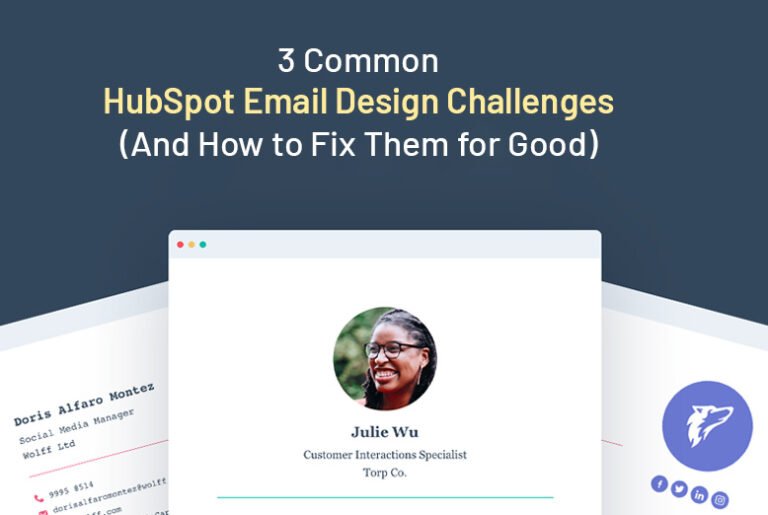You start building a HubSpot email design like you’re planning a quick dinner. Just a handful of clicks, punch in the copy, and a dash of images, done.
But somewhere between “this will be easy” and “why is this text block suddenly locked?” you’ve got seventeen tabs open, you’re Googling “HubL code for beginners,” and you’ve started whispering threats to Outlook’s rendering engine.
That’s the thing about HubSpot email templates: they can be powerful, flexible, and downright beautiful… until they’re not.
One minute you’re dragging and dropping like a pro, the next you’re stuck in a glue of half-editable modules, mysterious alignment shifts, and previews that look perfect but are not.
The good news? Every one of these headaches has a fix, and we’ve got them.
Let’s unpack three of the most common HubSpot email layout challenges and share some practical ways to fix them.
Challenge 1: HubL & Custom Code Complexity
HubSpot’s proprietary templating language, HubL, is amazing. As marketers, you can create highly personalized and dynamic HubSpot email templates with HuBL.
Conditional logic, token personalization, and data-driven content integration are some of its features you can apply to amp up your email relevance and engagement rates.
But you know what comes with HuBL’s power? You guessed it. The complexity.
- Not for every marketer. But for those of you who lack fluency in coding, navigating HubL can give you an experience of wandering into a foreign city without a map. Disorienting.
- Writing or modifying HubL code is no cakewalk without developer support. Otherwise, it slows down your email production cycle and ruffles some feathers in your teams that want quick campaign execution.
Why does this happen?
HubL is a scripting language designed exclusively for HubSpot templates. It’s where HTML, CSS, and proprietary tags and logic come together.
The drag-and-drop editor is unbeatable for structure and styling. However, when you require true customization or advanced dynamic content, HubL takes the lead.
The trouble with it is that making even small edits in HuBL means understanding coding basics and HubSpot’s unique syntax. Which is why marketers who don’t have these skills on tap find HubSpot email design challenging.
What’s the solution:
- Go for pre-built HubL templates with editable modules. Skilled developers can package HubL logic behind clean, editable fields, so you personalize emails through simple input fields. No question of code.
- Mix drag-and-drop with lightweight HubL snippets. Use HubSpot’s visual tools for layout. Then sprinkle in personalization snippets, which you can do without coding changes.
- Build skills or bring in a partner. Get your team trained in HubL. If not, bring in specialists who can handle your tough template builds like child’s play. It’s a small investment, but it can significantly reduce turnaround times while maintaining quality.
Challenge 2: Modular Design Restrictions: The Lock-In Problem of Drag-and-Drop Templates
HubSpot’s drag-and-drop editor brings stupid simplicity to the marketers who prefer to build emails visually. But after a round of heavy customization of a drag-and-drop template, the modules become partially locked.
What’s going on here?
As you go on with extensive editing and customization using drag-and-drop, some modules within the template become fixed. This limits your ability to rearrange, add, or fully edit certain content blocks.
What’s the root cause of this?
This occurs because HubSpot locks certain modules to maintain the integrity of the HubSpot email layout. It’s a safeguard against design breakage in different email clients. But it also leads to a more rigid structure after heavy customization.
Why do marketers feel the pinch because of this?
- Less room to pivot when campaign strategy or creative direction shifts.
- Extra reliance on developers to “unlock” or rebuild templates, which slows timelines and inflates costs.
- Harder to strike a balance between brand consistency and flexible design across multiple campaigns.
What’s the solution:
- Ask your developer for fully customizable HubSpot email templates. They are coded for maximum modularity, ensuring that modules remain editable, regardless of the number of revisions made.
- Choose reusable content blocks. Mix and match these modules to build templates twice as fast.
Challenge 3: Rendering & Testing Gaps
If there’s one thing that can send an email marketer’s blood pressure soaring, it’s finding out that an email looks perfect everywhere, especially in Outlook.
But sometimes, those previews don’t always paint the full picture. Marketers often discover that emails are rendered differently across email clients, with Outlook being notorious for its inconsistent display of images, fonts, and layouts.
What looks flawless in one preview may arrive looking broken or clunky in the inbox.
Why are rendering issues so persistent?
Every email client interprets HTML and CSS in their own way. Outlook, for instance, uses Microsoft Word’s rendering engine, a relic with limited support for modern design techniques.
Even though HubSpot’s drag-and-drop builder uses responsive HTML designed for broad compatibility, these client-specific quirks are difficult to avoid entirely.
What’s the solution:
- Hand-coded HubSpot email templates are your ally. Experienced developers custom-code them with client compatibility as the main goal. So that your emails render across all major email clients minus hiccups.
- Test like it’s a pre-launch ritual. Pair HubSpot’s preview with tools like Litmus or Email on Acid to see exactly how your email will appear in dozens of clients and devices.
- Keep layouts lean. The more complex the design, the more chances for it to break. Clean HubSpot email layouts are proven to survive client quirks far better than those kitchen-sink builds.
Grasping HubSpot Email Templates with Expert Solutions
HubSpot email templates are super effective—provided you navigate their challenges. HubL’s custom code, locked modules, or the infamous rendering headaches, none of these challenges are deal-breakers.
The winning approach is marries simplicity with flexibility:
- Invest in expertly crafted, custom-coded HubSpot email templates that keep personalization fuss-free for non-developers.
- Opt for modular frameworks. They’re designed to be adaptable and reusable.
- Treat testing as non-negotiable. Combine it with the latest coding practices and thorough pre-send checks to guarantee flawless rendering everywhere.
Also read; Maximizing Impact: The Power of Email Delivery Consulting in Modern Marketing



